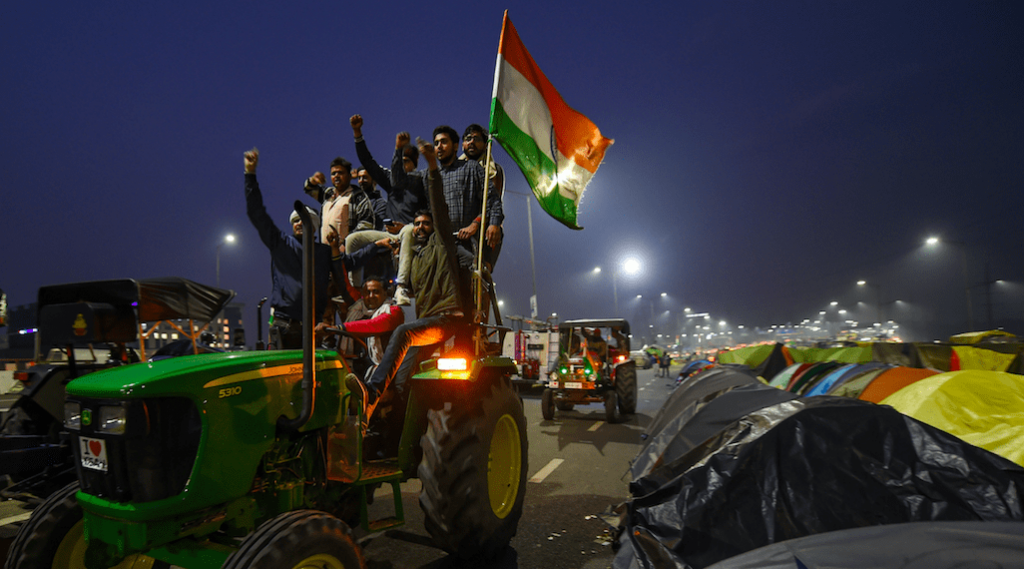Even as the Central government and its acolytes in the media work overtime to sell the benefits of the three new farm laws to the Indian public, the farmers protesting on Delhi’s borders have made it clear that they will not retreat till these laws are repealed. Caught between the crossfire of misinformation and facts, the average urban Indian is somewhat confused about the merits and demerits of the farmers’ protest – which has now crossed the 50-day mark.
If there is one thing that has become increasingly obvious over the least seven weeks, it is that big-city dwellers in India live in a very different universe than their rural counterparts, and have a difficult time understanding why the farmers camped on Delhi’s borders are as determined as they are to have their way. One major reason for that is they do not know the ‘back story’ of the protests.
In order to relieve some of that confusion and shed light on the larger context of this movement, I spoke to journalist, author, and food and trade policy expert, Devinder Sharma, who has spent the last two decades campaigning for income equality for Indian farmers and asked him the five questions that invariably come up most frequently whenever the topic of the farmers’ protests comes up for discussion.
Why are farmers so unhappy with the Central government?
Many think that it is just the three new farm laws that have agitated the farming community and that is why they are at the doorsteps of New Delhi. The way I see it, though, is that this is anger that has compounded over decades and is finally finding an outlet. Three studies show how agriculture has faced huge injustice and inequality and has been deprived of its rights over the last 30 or 40 years.
A study by UNCTAD shows that for 20 years, between the mid-1980s and the mid-2000s, the output price or the farm gate price of agriculture remained static across the globe. In other words, farmers’ income in the 2000s (after adjusting for inflation) remained the same as it was in the 1980s. Rich countries, of course, addressed this issue by providing direct income support and a whole lot of other privileges to the farming communities, but the developing countries could not afford it and farmers in these countries have silently suffered the consequences ever since.
Then came a study in 2008 by OECD (Organization for Economic Cooperation and Development) along with a New Delhi think tank which estimated that between 2010 and 2016-17, Indian farmers lost Rs 45 lakh crores in farm incomes! What was even more extraordinary than this crisis was the lack of discussion around it. And this was for only for a handful of crops, so the total extent of the loss that the farmers have suffered must have been significantly higher. This meant a loss of about Rs. 2.64 lakh crore every year because farmers were denied their rightful income.
Yet another report by the Economic Survey in 2016 tells us that the average income of a farming family in 17 states of India, about half the country, is only Rs. 20,000 a year, or less than Rs 1,700 rupees a month. I can’t even raise a cow in that amount! I shudder to think how the farming community has been surviving in half of India.
All that to say that agriculture has been passing through a terrible crisis all these decades, and the fact that farmers have assembled at the borders of New Delhi in the dead of winter shows they have had enough. The academia, the elite, and the economists have all failed to help farmers get their rightful dues, and so now they have taken it upon themselves to fight for their survival.
With these farm laws being introduced, they fear that whatever they have left is also going to be snatched away. That is what has pushed them into this kind of protest which is an iconic one, of a kind at least I have not seen anywhere in the world.
But isn’t this primarily a protest by rich Punjabi farmers?
If the Punjab farmers were so rich, then they should have been a model for the rest of the country to follow. But a study done jointly by the Punjab Agricultural University, Ludhiana, Punjabi University, Patiala and Guru Nanak Dev University in Amritsar — all public sector universities — showed that between 2000 and 2015, 16,600 farmers and farm workers committed suicide. Incidentally, the total debt that Punjab farm households are reeling under is Rs 1 lakh crore!
If the farmers were rich, why did they commit suicide in such large numbers? Pick up a Punjabi newspaper, and chances are that you will find one or two suicides being reported almost daily. Also, every third farmer in Punjab happens to be below the poverty line.
Let us not forget that, in this country, only 4% farmers have land holdings which are more than 10 hectares. So, what kind of rich farmers are we talking about, when only 4% farmers have more than 10 acres of land? 86% farmers in India have a landholding size of less than five acres. The remaining are what are called median or medium farmers who have a land holdings of 6 to 8 acres.
To say that this agitation is being led by the farmers who are rich just because they get minimum support price is ridiculous. In Punjab, roughly 70% of the small farmers get the benefit of minimum support price. Small farmers are those who have less than five acres. They are the ones who benefit largely from the minimum support price.
And to those who say that this is a protest instigated by opposition parties, please go and stay outside your home for one night in the dead of winter to see what it’s like. I don’t think anybody will do that even if they are paid to. Just spend one night in a trolley or tent on a road outside Delhi, and tell me if you would do that for more than a month even if you were paid to. I think it’s time to stop being so contemptuous towards the farming community. Let’s honour and respect the protesting farmers, and try to see what they need and what we can do to help.
But aren’t most farmer unions in favour of these laws?
If the majority of farmers were in favour of these laws, would the number of them on protest be this huge? In fact, it is remarkable that so many farmer unions have come together on one platform. As someone who has worked with farmers for over two decades, I know how difficult it is to get different farmer unions to see eye to eye. And yet, here you have 32 union leaders from Punjab, and many others from Haryana, Rajasthan, Western UP, and other parts of the country. It just shows that the situation is now dire enough for them to put their differences aside and come together for their survival.
As far as the “groups” who are saying that these laws are good, it’s not very difficult to hold up a visiting card saying that you represent x farmer group. We have seen it happen earlier and we are seeing that happening now. What is more important to remember, though, is that such a large section of farmers have actually come out together in strong protest.
Even if a chunk of the farming population is unhappy, isn’t it important to try and understand why they are unhappy and then try and help them, instead of trying to minimise their distress and their numbers?
What is so bad about corporates getting into agriculture?
I was being interviewed on a business channel the other day, and the host asked me, “At a time when the markets are so excited about these farm laws, why are the farmers unhappy?”
I said, “You have answered your own question. The laws are in favour of the market, so of course they are excited. And the farmers feel the laws are not in their favour, and so they are on the streets.”
The world is moving towards corporate agriculture, but contrary to what corporations would like you to think, corporate involvement in agriculture has not boosted farmers’ income. Take the United States, for example, from where we have borrowed these laws. In America, open markets and free trade in agriculture have existed for over six to seven decades, and yet farm incomes there have been in decline. In fact, in 2020, American farmers were saddled with a bankruptcy of more than $425 billion.
If the reforms were so good, why would farmers be faced with that kind of bankruptcy? Most Indians don’t know that America is also passing through a terrible agrarian crisis. In fact, the rate of suicide in rural America is about 45% higher than it is in urban America.
Over the years, small farms in the US have disappeared and only 1.5% of America’s population is now engaged in farming. And yet, the US continues to be the biggest agriculture producer in the world. (Of course when we talk of agriculture in America, we are talking about big machines, big corporates, big business and big agriculture. But when we talk about agriculture in India, we’re talking about millions of small farmers, marginal farmers.)
In America, they don’t have MSP, or APMCs. There, big retailers like Walmart do not have stock limits. They also have contract farming, and do commodity trading, and yet, despite all of that, American farmers are given a subsidy of $62,000, every year. Which begs the question — If open markets are really that efficient, why does the government pump in so much money into the agriculture sector?
The OECD countries, the richest trading bloc in the world, pump billions of dollars into agriculture every year by way of direct income support or subsidies. Europe today is giving about $100 billion of agricultural subsidies annually and roughly half of it goes as direct income support to farmers. So, what we see as ‘market efficiency’ in agriculture or agriculture export, is actually federal support that governments have been providing to the agricultural sector.
We need to be very clear that agriculture is sustainable and viable in rich and developed countries not because the markets are efficient, but because the government provides subsidy support year after year.
China, incidentally, has now emerged as the biggest provider of agricultural subsidies in the world, beating even America and the European Union. The Chinese government provided $212 billion dollars worth of subsidy support to its agricultural sector in 2016. 38% of the earnings of wheat farmers actually comes from subsidies, as does about 32% of the earnings of the rice farmers. It is not the high yield that they have, but subsidies that gives farmers high income.
Then there is the issue of technology. You’ve heard it all – “When technology comes in, then productivity goes up and income goes up,” etc. Well, since the 1970s, the US had a number of small dairy farms. These dairy farms were technology-rich, and the cattle they had were high- yielding. In fact, American dairy farms were a model for us to follow. But about ten years ago, I read a shocking report in New York Times about a farmer suicide. This farmer was so distressed by the market crash in milk prices, that he first shot each of his 51 cows, and then he shot himself.
The point I’m trying to make is that distress has prevailed in America over the decades and we don’t even know about it. If you look closely at what has happened in the US, 93% of the dairy farms have closed down since the 1970s, but milk production has gone up. This is because big corporates have moved into agriculture and set up mega dairies and this has led to milk prices crashing and 93% of dairy farms closing down.
If technology and productivity were indeed the criteria for agricultural success, then I see no reason why those dairy farms would have closed. They closed down because of the market prices they were getting, which just kept declining. It came to the point that they could not even cover their costs of production, and so they just left farming.
This is a warning for us, and is only one of many examples that show how the things that are supposed to increase farmer income actually don’t. What farmers need is direct income support. In Europe, 50% of the subsidies are allocated for direct income support. The US gives $62,000 as subsidy support or an average to each farmer in a year.
I think it tells us that markets are not what are sustaining agriculture; it is primarily subsidies which sustain whatever remains in agriculture today.
So what do you see as the way forward? How can agriculture be saved and revived?
This is a critical juncture in our history and this farmers’ movement should actually make us all sit up and think about the corrections that need to be made.
First of all, like you and I need some sort of assured income, every farmer also needs to have an assured price for his produce. He needs to be sure that after the harvest, when he goes into the mandi, he will at least get that minimum price. If there can be a minimum wage for the workers, I don’t understand why there can’t be a minimum price for the farmers.
The only way I know to ensure that is MSP. In fact, that is a strength of India, because our policymakers did a remarkable thing at the time of green revolution — they introduced a minimum support price. That is something which has stood the test of the time. I also agree there are problems in the mandis, but we need to reform their structure, not shut them down. Throwing out the mandis is like throwing the baby out with the bathwater.
I would suggest that the government make MSP legal for the 23 crops that it announces MSP for every year. Every year the government announces minimum support price for 23 crops but effectively buys only wheat and paddy. (To some extent, cotton and pulses too, as the need arises, but primarily wheat and paddy.) This needs to be extended to all the crops.
An analysis in The Wire showed that in October and November of 2020, in just two months, based on the government’s own portal where they give you details about how many different crops have been sold in these two months and at what the price etc. — If the farmers had gotten MSP for all crops across the board and not just for wheat and paddy, they would have gained by Rs 1900 crores in just two months! I’m sure you will agree that is not a small amount, and considering that in half the country, the average income is only Rs 20,000 a year, imagine the economic benefit the farmers would have received
80% of the gross crop area in India is covered by these 23 crops. That means a large section of the farming population is covered by a minimum support price regime if it is implemented effectively or made legal. That would be real azadi for farmers. He would know that whether he sells in Punjab or Bihar, he will be getting the same price, the minimum support price. That’s the kind of freedom that the farmers are expecting.
Corporates are saying they will now be able to give farmers a higher price for their produce! But higher price than what? The only benchmark we have is MSP. So if corporates, policymakers and economists are already willing to pay a “higher price”, then what is the problem in setting MSP as a minimum income that the farmer is assured of? The corporate sector should be standing with the farmer saying, “Yes, let’s make MSP a legal right, because we are in any case going to give them a higher price.”
But that’s not happening, which means the corporates are not being honest. They know that they will not be able to give a higher price.
Many ‘corporate activists’ who appear on the television have been saying that if the Center brings in a fourth law, which makes the minimum support price across the country legal, then the reforms would collapse and crash! — That means you are yourself admitting that you are not going to give farmers a higher price!
Secondly, delivering minimum support price poses its own set of challenges. In this country we have about 7000 APMC-regulated mandis. What we need in this country is 42,000 mandis within a five-kilometre radius. That is infrastructure we have to create, so farmers can sell their produce easily. If you have a good network of mandis laid out, then the mechanism of MSP delivery becomes easy.
In America, after all these decades of the free market, the US Department of Agriculture tells us that the share of a farmer in every food dollar is only 8 cents. This means if the consumer is spending $1 on buying food, then the farmer’s share is only 8%. This should tell us very clearly why the American farmer is in a crisis today.
Now compare that with Amul Dairy Co-operative in India. The Managing Director of Amul Dairy Cooperative has gone on record saying that when you buy Amul milk for Rs 100, Rs 70 of that goes to the farmers. The farmer’s share is 70%! So why not draw a lesson from Amul and replicate that model in vegetables, pulses, fruits, etc, to ensure that the farmers get a larger share of the profit?
Why are we ashamed of our homegrown models? Let’s learn from our own strengths and build on them. Instead of opening up agriculture for the corporates to exploit, let’s expand the cooperative network in this country. Let’s experiment and learn how to make that work for vegetables and fruits.
One last thing — our economic design has treated agriculture as a burden on society. The argument is that unless we move people out of agriculture into the urban areas, we will not have economic growth. This has to change. In just two days of lockdown, we saw 80 million people go into reverse migration both interstate and intrastate, and that tells us that, that the model of pushing people out of the urban areas, was a flawed, economic model. And I think we need to reverse that model. The possibility of making, agriculture a powerhouse of economic growth is what is required today.
Rohit Kumar is an educator with a background in positive psychology and psychometrics. He works with high school students on emotional intelligence and adolescent issues to help make schools bullying-free zones. He can be reached at letsempathize@gmail.com.

















